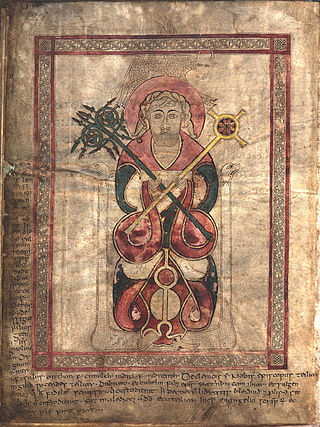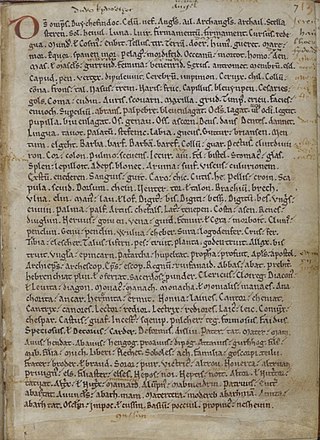
The Brittoniclanguages form one of the two branches of the Insular Celtic language family; the other is Goidelic. It comprises the extant languages Breton, Cornish, and Welsh. The name Brythonic was derived by Welsh Celticist John Rhys from the Welsh word Brython, meaning Ancient Britons as opposed to an Anglo-Saxon or Gael.
Old English, or Anglo-Saxon, is the earliest recorded form of the English language, spoken in England and southern and eastern Scotland in the early Middle Ages. It developed from the languages brought to Great Britain by Anglo-Saxon settlers in the mid-5th century, and the first Old English literary works date from the mid-7th century. After the Norman Conquest of 1066, English was replaced for several centuries by Anglo-Norman as the language of the upper classes. This is regarded as marking the end of the Old English era, since during the subsequent period the English language was heavily influenced by Anglo-Norman, developing into what is now known as Middle English in England and Early Scots in Scotland.

Taliesin was an early Brittonic poet of Sub-Roman Britain whose work has possibly survived in a Middle Welsh manuscript, the Book of Taliesin. Taliesin was a renowned bard who is believed to have sung at the courts of at least three kings.
Cumbric was a variety of the Common Brittonic language spoken during the Early Middle Ages in the Hen Ogledd or "Old North" in what is now the counties of Westmorland, Cumberland, northern Lancashire in Northern England and the southern Scottish Lowlands. It was closely related to Old Welsh and the other Brittonic languages. Place name evidence suggests Cumbric may also have been spoken as far south as Pendle and the Yorkshire Dales. The prevailing view is that it became extinct in the 12th century, after the incorporation of the semi-independent Kingdom of Strathclyde into the Kingdom of Scotland.
Old French was the language spoken in most of the northern half of France approximately between the late 8th and the mid-14th century. Rather than a unified language, Old French was a linkage of Romance dialects, mutually intelligible yet diverse. These dialects came to be collectively known as the langues d'oïl, contrasting with the langues d'oc, the emerging Occitano-Romance languages of Occitania, now the south of France.

The Lichfield Gospels is an 8th-century Insular Gospel Book housed in Lichfield Cathedral. There are 236 surviving pages, eight of which are illuminated. Another four contain framed text. The pages measure 30.8 cm by 23.5 cm. The manuscript is also important because it includes, as marginalia, some of the earliest known examples of written Old Welsh, dating to the early part of the 8th century. The art historian Peter Lord dates the book at 730, placing it chronologically before the Book of Kells but after the Lindisfarne Gospels.

Beli Mawr was an ancestor figure in Middle Welsh literature and genealogies. He is the father of Cassivellaunus, Arianrhod, Lludd Llaw Eraint, Llefelys, and Afallach. In certain medieval genealogies he is listed as the son or husband of Anna, cousin of Mary, mother of Jesus. According to the Welsh Triads, Beli and Dôn were the parents of Arianrhod, but the mother of Beli's other children—and the father of Dôn's other children—is not mentioned in the medieval Welsh literature. Several royal lines in medieval Wales traced their ancestry to Beli. The Mabinogi names Penarddun as a daughter of Beli Mawr, but the genealogy is confused; it is possible she was meant to be his sister rather than daughter.

Ogham is an Early Medieval alphabet used primarily to write the early Irish language, and later the Old Irish language. There are roughly 400 surviving orthodox inscriptions on stone monuments throughout Ireland and western Britain, the bulk of which are in southern Munster. The largest number outside Ireland are in Pembrokeshire, Wales.
The Celtic calendar is a compilation of pre-Christian Celtic systems of timekeeping, including the Gaulish Coligny calendar, used by Celtic countries to define the beginning and length of the day, the week, the month, the seasons, quarter days, and festivals.

Y Gododdin is a medieval Welsh poem consisting of a series of elegies to the men of the Brittonic kingdom of Gododdin and its allies who, according to the conventional interpretation, died fighting the Angles of Deira and Bernicia at a place named Catraeth in about AD 600. It is traditionally ascribed to the bard Aneirin and survives only in one manuscript, the "Book of Aneirin".
Medieval Welsh literature is the literature written in the Welsh language during the Middle Ages. This includes material starting from the 5th century AD, when Welsh was in the process of becoming distinct from Common Brittonic, and continuing to the works of the 16th century.
Old Irish, also called Old Gaelic, is the oldest form of the Goidelic/Gaelic language for which there are extensive written texts. It was used from c. 600 to c. 900. The main contemporary texts are dated c. 700–850; by 900 the language had already transitioned into early Middle Irish. Some Old Irish texts date from the 10th century, although these are presumably copies of texts written at an earlier time. Old Irish is thus forebear to Modern Irish, Manx and Scottish Gaelic.

Primitive Irish or Archaic Irish, also called Proto-Goidelic, is the oldest known form of the Goidelic languages, and the ancestor of all languages within this family.

Brut y Brenhinedd is a collection of variant Middle Welsh versions of Geoffrey of Monmouth's Latin Historia Regum Britanniae. About 60 versions survive, with the earliest dating to the mid-13th century. Adaptations of Geoffrey's Historia were extremely popular throughout Western Europe during the Middle Ages, but the Brut proved especially influential in medieval Wales, where it was largely regarded as an accurate account of the early history of the Celtic Britons.
Bonedd Gwŷr y Gogledd is a brief Middle Welsh tract which claims to give the pedigrees of twenty 6th century rulers of the Hen Ogledd, the Brittonic-speaking parts of southern Scotland and northern England. It is attested in a number of manuscripts, the earliest being NLW, Peniarth MS 45, which has been dated to the late 13th century. The text may have been composed in the 12th century. The historicity of much of the information is spurious or in doubt. Although certain parts are in agreement with the earlier Harleian genealogies, the text represents a substantial revision seeking to integrate the branches of many rulers and heroes who are prominent in other traditions, such as the Rheged prince Llywarch Hen.
Talhaearn Tad Awen, was, according to medieval Welsh sources, a celebrated British poet of the sub-Roman period. He ranks as one of the earliest, if not the earliest, named poets to have composed and performed in Welsh. The better known poets Aneirin and Taliesin, who may have been slightly younger contemporaries, also belong to this early generation, the first of those known to modern scholars as the Cynfeirdd. Whereas medieval Welsh manuscripts preserve verse composed by or otherwise ascribed to the latter two figures, no such work survives for Talhaearn and in fact, his former fame seems to have largely vanished by the later Middle Ages.
Common Brittonic, also known as British, Common Brythonic, or Proto-Brittonic, is an extinct Celtic language spoken in Britain and Brittany.
The Juvencus Manuscript is one of the main surviving sources of Old Welsh. Unlike much Old Welsh, which is attested in manuscripts from later periods and in partially updated form, the Welsh material in the Juvencus Manuscript was written in the Old Welsh period itself; the manuscript provides the first attestation of many Welsh words.

The Vocabularium Cornicum, also known as the Cottonian Vocabulary or the Old Cornish Vocabulary, is a Latin-Old Cornish glossary. It is usually interpreted as an Old Cornish translation of Ælfric of Eynsham's Latin-Old English Glossary, and it is considered to be the most substantial extant document of the Old Cornish period. The only surviving copy, part of a composite manuscript known as MS Cotton Vespasian A. XIV, is now kept in the British Library, and is thought to have been copied around 1200 AD from an earlier exemplar.
Neo-Brittonic, also known as Neo-Brythonic, is a stage of the Insular Celtic Brittonic languages that emerged by the middle of the sixth century CE. Neo-Brittonic languages include Old, Middle and Modern Welsh, Cornish, and Breton, as well as Cumbric.








